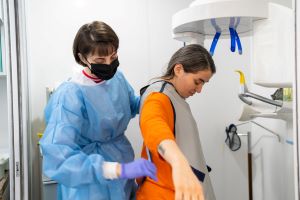Many patients are used to donning large, heavy aprons when getting a dental X-ray. Since the 1950s, providers have thought it was vital to cover a patient’s body and throat for fear of exposing their reproductive organs, thyroid gland, and pregnancy to dangerous levels of radiation.

Erika Benavides, DDS, PhD
Over the last decade, however, evidence about this practice has grown. This year, the American Dental Association (ADA) released new data showing:
- It’s safe for patients of all ages and conditions, including pregnancy, to “shed the shields” during maxillofacial imaging.
- Better diagnostic images can be captured without lead aprons and thyroid collars.
CareQuest Institute collaborated with the ADA on a webinar featuring one of the experts who jointly developed the 2024 guidelines. Erika Benavides, DDS, PhD, diplomate, American Board of Oral and Maxillofacial Radiology, clinical professor at the University of Michigan, shared insights on implementing these recommendations.
Here are answers to 11 audience questions (edited for space):
1. If a parent or caregiver must stay in the room while their child gets an X-ray, should they be shielded?
Ideally, everyone but the patient should be out of the exam room during an X-ray. However, caregivers should be shielded if they must stay to support a patient.
2. Some patients with heart monitors cannot undergo X-ray screenings at the airport. Are dental X-rays safe for them?
Yes, dental imaging is safe for patients who have any kind of cardiac device.
3. Should dental team members wear their own shields when operating NOMAD portable X-rays?
It is important to recognize that the new recommendations only focus on ending patient shielding. They don’t change guidelines on protection for clinicians. In general, providers operating handheld dental X-rays should always follow manufacturer’s instructions.
On a more detailed note, providers should be aware that:
- NOMADs do have a built-in radiation backscatter shield.
- NOMADs come with strict manufacturer instructions that are important for clinicians to follow. For example, providers should hold the device with its arm at a 90-degree angle, away from their body.
- If the NOMAD operator cannot follow its strict handling instructions, they should wear a lead apron.
4. In offices that still use circular collimators on their X-rays, should patients continue wearing radiation shields?
The short answer is no, patients do not need to wear shields even when a collimator is round. However, the National Council on Radiation Protection and Measurements recommends using rectangular collimators as one way to limit patients’ radiation exposure.
To align with these best practices, consider adding a beam-guiding device on machines with circular collimators. Some beam-guiding devices have their own rectangular shield at the open end of the ring, which can be attached to round collimators to allow rectangular collimation.
5. What are the differences in radiation risk for children and adults? 
Data show varying levels of risk for thyroid cancer depending on a patient’s age:
- Young people aged 19 and under have thyroid glands that are generally more sensitive to radiation than adults.
- Children between 10 and 19 years old have thyroids that are three times more sensitive to radiation than adults.
- The thyroid gland in preschoolers and younger children, between 3 and 10 years old, is 10 times more sensitive to radiation than adults.
When taking X-rays of the youngest patients, providers should follow protocols to reduce radiation exposure as much as possible, such as with digital sensors and rectangular collimation.
6. Are there any unique concerns facing patients who have cancer, including thyroid cancer, or people undergoing radiation therapy for cancer?
It is safe for cancer patients to get dental X-rays. Dental radiography delivers a negligible dose of radiation compared to their cancer treatment.
When caring for patients undergoing radiation therapy, a greater concern is the tissue in their mouth. It may be much more sensitive than normal due to cancer treatment. Providers should be very careful to avoid wounding a patient when placing sensors in their mouth.
7. Can you comment on providers who, when working with children, may need to hold the radiograph?
If a child needs support holding a digital sensor or plate in their mouth, providers should recruit their parent or caregiver for assistance. Clinicians should never be the one to hold these devices in a child’s mouth.
8. Does wearing a lead apron hold radiation on the body or promote scatter?
Internal scatter radiation is when radiation interacting with one area of a patient’s body travels to another — for example, from their chest to their abdomen. Lead shields do not hold radiation on the patient or cause internal scatter, nor do they protect against it.
9. Will state laws need to catch up with the new guidance and when might that happen?
Some states, such as Michigan, do not currently require patient shields during dental X-rays. In similar states, dental teams should be able to implement the new recommendations immediately.
In other states, such as California, lead aprons are required. While we would hope regulatory changes would take no longer than 6–12 months, updating rules can take some time.
10. How often should radiography equipment and lead aprons be replaced?
X-ray machines do have a lifecycle. Factors to consider for replacing them include:
- Machines that use an alternating current should be replaced with ones that have a direct current.
- Intraoral X-ray equipment should have a relatively high kVp.
For lead aprons, their lifecycle depends on:
- How often patients use them
- If providers consistently handle them properly, such as storing them on hangers
Visible damage is a sign that it’s time to replace an apron.
11. Is there written guidance urging dentists to order radiographs based on exams rather than set intervals?
The ADA’s new priority recommendations include:
- Providers should order radiographs based on diagnostic and treatment planning needs, not on a set frequency.
- Dentists should make a good faith attempt to obtain radiographs from previous exams.
However, there is a recommended frequency for recalled bitewings. Providers should keep in mind two important points:
- Rather than a set interval, the ADA advises a range of time, such as between 12 and 24 months or between 24 and 36 months.
- This frequency is just a recommendation. Each patient may be different.
Recalled bitewing radiographs should be based on each patient’s circumstances, such as their age, specific caries risk, or findings from a clinical exam. This aspect of care should be a patient-centered decision.
